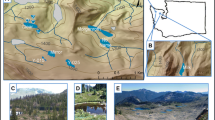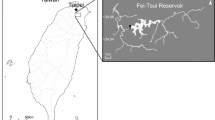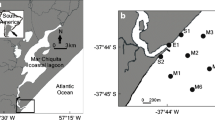Abstract
Aquatic food webs are supported by primary production from within the system (autochthony) as well as organic matter produced outside of and transported into the system (allochthony). Zooplankton use allochthonous resources, especially in systems with high terrestrial loading and moderate to low internal primary production. We hypothesized that due to high terrestrial loads and remnant submerged terrestrial material, allochthonous resource use by zooplankton would be significant in all reservoirs and would decline along an increasing reservoir age gradient. Using hydrogen stable isotopes and a Bayesian mixing model, we estimated the contribution of allochthonous sources to organic matter pools and crustaceous zooplankton biomass for ten reservoirs. Dissolved organic matter (DOM) in all systems was dominated by allochthonous sources (posterior distribution median >92% allochthonous), while particulate organic matter (POM) composition varied (2–68% allochthonous) and had a lower allochthonous fraction in older reservoirs. There was no relationship between zooplankton allochthony and reservoir age. Crustaceous zooplankton allochthony varied among systems from 26 to 94%, and Chaoborus allochthony, measured in four reservoirs, was similarly variable (33–94%). Consumer allochthony was higher than POM allochthony in some reservoirs, potentially due to terrestrial DOM pathways being important and/or algal resources being inedible (e.g., cyanobacteria). As with many lakes, in the reservoirs we studied, allochthonous inputs account for a significant fraction of the organic matter of basal consumers.




Similar content being viewed by others
References
Abril, G., F. Guérin, S. Richard, R. Delmas, C. Galy-Lacaux, P. Gosse, A. Tremblay, L. Varfalvy, M. Aurelio Dos Santos & B. Matvienko, 2005. Carbon dioxide and methane emissions and the carbon budget of a 10 year old tropical reservoir (Petit Saut, French Guiana). Global Biogeochemical Cycles 19: GB4007.
Babler, A., A. Pilati & M. Vanni, 2011. Terrestrial support of detritivorous fish populations decreases with watershed size. Ecosphere. doi:10.1890/ES11-00043.1.
Barros, N., J. J. Cole, L. J. Tranvik, Y. T. Prairie, D. Bastviken, V. L. M. Huszar, P. del Georgio & F. Roland, 2011. Carbon emission from hydroelectric reservoirs linked to reservoir age and latitude. Nature Geosciences 4: 593–596.
Berggren, M., L. Ström, H. Laudon, J. Karlsson, A. Jonsson, R. Giesler, A. K. Bergström & M. Jansson, 2010. Lake secondary production fueled by rapid transfer of low molecular weight organic carbon from terrestrial sources to aquatic consumers. Ecology Letters 13: 870–880.
Berggren, M., S. E. Ziegler, N. F. St-Gelais & B. E. Beisner, 2014. Contrasting patterns of allochthony among three major groups of crustacean zooplankton in boreal and temperate lakes. Ecology 95: 1947–1959.
Berggren, M., A. K. Bergström & J. Karlsson, 2015. Intraspecific autochthonous and allochthonous resource use by zooplankton in a humic lake during the transitions between winter, summer and fall. PLoS One 10: e0120575.
Brothers, S. M., Y. T. Prairie & P. A. del Giorgio, 2012. Benthic and pelagic sources of carbon dioxide in boreal lakes and a young reservoir (Eastman-1) in eastern Canada. Global Biogeochemical Cycles 26: GB1002.
Chao, B. F., Y. H. Wu & Y. S. Li, 2008. Impact of artificial reservoir water impoundment on global sea level rise. Science 320: 212–214.
Cole, J. J. & C. T. Solomon, 2012. Terrestrial support of zebra mussels and the Hudson River food web: a multi-isotope, Bayesian analysis. Limnology and Oceanography 57: 1802–1815.
Cole, J. J., S. R. Carpenter, M. L. Pace, M. C. Van de Bogert, J. L. Kitchell & J. R. Hodgson, 2006. Differential support of lake food webs by three types of terrestrial organic carbon. Ecology Letters 9: 558–568.
Cole, J. J., S. R. Carpenter, J. F. Kitchell, M. L. Pace, C. T. Solomon & B. Weidel, 2011. Strong evidence for terrestrial support of zooplankton in small lakes based on stable isotopes of carbon, nitrogen, and hydrogen. Proceedings of the National Academy of Sciences USA 108: 1975–1980.
DeMott, W. R., Q. Zhang & W. W. Carmichael, 1991. Effects of toxic cyanobacteria and purified toxins on the survival and feeding of a copepod and three species of Daphnia. Limnology and Oceanography 36: 1346–1357.
Doucett, R. R., J. C. Marks, D. W. Blinn, M. Caron & B. W. Hungate, 2007. Measuring terrestrial subsidies to aquatic food webs using stable isotopes of hydrogen. Ecology 88: 1587–1592.
Downing, J. A., Y. T. Prairie, J. J. Cole, C. M. Duarte, L. J. Tranvik, R. G. Striegl, W. H. McDowell, P. Kortelainen, N. F. Caraco, J. M. Melack & J. J. Middelburg, 2006. The global abundance and size distribution of lakes, ponds, and impoundments. Limnology and Oceanography 51: 2388–2397.
Francis, T. B., D. E. Schindler, G. W. Holtgrieve, E. R. Larson, M. D. Scheuerell, B. X. Semmens & E. J. Ward, 2011. Habitat structure determines resource use by zooplankton in temperate lakes. Ecology Letters 14: 364–372.
Ghadouani, A., B. Pinel-Alloul & E. F. Prepas, 2003. Effects of experimentally induced cyanobacterial blooms on crustacean zooplankton communities. Freshwater Biology 48: 363–381.
Guenet, B., M. Danger, L. Abbadie & G. Lacroix, 2010. Priming effect: bridging the gap between terrestrial and aquatic ecology. Ecology 91: 2850–2861.
Grey, J. & R. I. Jones, 1999. Carbon stable isotopes reveal complex trophic interactions in lake plankton. Rapid Communications in Mass Spectrometry 13: 1311–1314.
Grey, J. & R. I. Jones, 2001. Seasonal changes in the importance of the source of organic matter to the diet of zooplankton in Loch Ness, as indicated by stable isotope analysis. Limnology and Oceanography 46: 505–513.
Holm-Hansen, O. & B. Riemann, 1978. Chlorophyll a determination: improvements in methodology. Oikos 30: 438–447.
Homer, C., C. Huang, L. Yang, B. Wylie & M. Coan, 2004. Development of a 2001 national land-cover database for the United States. Photogrammetric Engineering & Remote Sensing 70: 829–840.
Hondula, K. L., M. L. Pace, J. J. Cole & R. D. Batt, 2014. Hydrogen isotope discrimination in aquatic primary producers: implications for aquatic food web studies. Aquatic Sciences 76: 217–229.
Jaffe, R., D. M. McKnight, N. Maie, R. Cory, W. H. McDowell & J. L. Campbell, 2008. Spatial and temporal variations in DOM composition in ecosystems: the importance of long-term monitoring of optical properties. Journal of Geophysical Research 113: G04032.
Jansson, M., L. Persson, A. M. de Roos, R. I. Jones & L. J. Tranvik, 2007. Terrestrial carbon and intraspecific size-variation shape lake ecosystems. Trends in Ecology and Evolution 22: 316–322.
Jeayong, L., Y. Lee, C. Jang, J. S. Owen, J. Kim, J. Eum, S. Jung & B. Kim, 2013. Stable carbon isotope signatures of zooplankton in some reservoirs in Korea. Journal of Ecology and Environment 36: 183–191.
Kalff, J., 2002. Limnology: Inland Water Ecosystems. Prentice Hall, Upper Saddle River.
Kankaala, P., S. Taipale, L. Li & R. I. Jones, 2010. Diets of crustacean zooplankton, inferred from stable carbon and nitrogen isotope analyses, in lakes with varying allochthonous dissolved organic carbon content. Aquatic Ecology 44: 781–795.
Karlsson, J., A. Jonsson, M. Meili & M. Jansson, 2003. Control of zooplankton dependence on allochthonous organic carbon in humic and clear-water lakes in northern Sweden. Limnology and Oceanography 48: 269–276.
Kelly, P. T., C. T. Solomon, B. C. Weidel & S. E. Jones, 2014. Terrestrial carbon is a resource, but not a subsidy, for lake zooplankton. Ecology 95: 1236–1242.
Knoll, L. B., M. J. Vanni & W. H. Renwick, 2003. Phytoplankton primary production and photosynthetic parameters in reservoirs along a gradient of watershed land use. Limnology and Oceanography 48: 608–617.
Lennon, J. T., A. M. Faiia, X. Feng & K. L. Cottingham, 2006. Relative importance of CO2 recycling and CH4 pathways in lake food webs along a dissolved organic carbon gradient. Limnology and Oceanography 51: 1602–1613.
Marcarelli, A. M., C. V. Baxter, M. M. Mineau & R. O. Hall, 2011. Quantity and quality: unifying food web and ecosystem perspectives on the role of resource subsidies in freshwaters. Ecology 92: 1215–1225.
Matthews, B. & A. Mazumder, 2005. Temporal variation in body composition (C:N) helps explain seasonal patterns of zooplankton δ 13C. Freshwater Biology 50: 502–515.
Matthews, B. & A. Mazumder, 2006. Habitat specialization and the exploitation of allochthonous carbon by zooplankton. Ecology 87: 2800–2812.
Mendonça, R., N. Barros, L. O. Vidal, F. Pacheco, S. Kosten & F. Roland, 2012. Greenhouse gas emissions from hydroelectric reservoirs: what knowledge do we have and what is lacking? In Liu, G. (ed), Greenhouse Gases – Emission, Measurement and Management. InTech, Rijeka: 55–78.
Mohamed, N. M. & W. D. Taylor, 2009. Relative contributions of autochthonous and allochthonous carbon to limnetic zooplankton: a new cross-system approach. Fundamental and Applied Limnology 175: 113–124.
Mulholland, P. J. & W. R. Hill, 1997. Seasonal patterns in streamwater nutrient and dissolved organic carbon concentrations: separating catchment flow path and in-stream effects. Water Resources Research 33: 1297–1306.
Pace, M. L., S. R. Carpenter, J. J. Cole, J. J. Coloso, J. F. Kitchell, J. R. Hodgson, J. J. Middleburg, N. D. Preston, C. T. Solomon & B. C. Weidel, 2007. Does terrestrial organic carbon subsidize the planktonic foodweb in a clear-water lake? Limnology and Oceanography 52: 2177–2189.
Persaud, A. D. & P. J. Dillon, 2011. Differences in zooplankton feeding rates and isotopic signatures from three temperate lakes. Aquatic Sciences 73: 261–273.
Rasmussen, J. B., 2010. Estimating terrestrial contribution to stream invertebrates and periphyton using a gradient-based mixing model for δ13C. Journal of Animal Ecology 79: 393–402.
Roach, K. A., 2013. Environmental factors affecting incorporation of terrestrial material in large river food webs. Freshwater Science 32: 283–298.
Semmens, B. X., E. J. Ward, J. W. Moore & C. T. Darimon, 2009. Quantifying inter- and intra-population niche variability using hierarchical Bayesian stable isotope mixing models. PLoS One 4: e6187.
Solomon, C. T., J. J. Cole, R. R. Doucett, M. L. Pace, N. D. Preston, L. E. Smith & B. C. Weidel, 2009. The influence of environmental water on the hydrogen stable isotope ratio in aquatic consumers. Oecologia 161: 313–324.
Solomon, C. T., S. R. Carpenter, M. K. Clayton, J. J. Cole, J. J. Coloso, M. L. Pace, M. J. Vander Zanden & B. C. Weidel, 2011. Terrestrial, benthic, and pelagic resource use in lakes: results from a three isotope Bayesian mixing model. Ecology 92: 1115–1125.
St. Louis, V. L., C. A. Kelly, E. Duchemin, J. W. M. Rudd & D. M. Rosenberg, 2000. Reservoir surfaces as sources of greenhouse gases to the atmosphere: a global estimate. BioScience 50: 766–775.
Stets, E. G., R. G. Striegl & G. R. Aiken, 2010. Dissolved organic carbon export and internal cycling in small, headwater lakes. Global Biogeochemical Cycles 24: GB4008.
Taipale, S., P. Kankaala, M. Tiirola & R. I. Jones, 2008. Whole-lake dissolved inorganic 13C additions reveal seasonal shifts in zooplankton diet. Ecology 89: 463–474.
Taipale, S. J., M. T. Brett, M. W. Hahn, D. Martin-Crezburg, S. Yeung, M. Hiltunen, U. Strandberg & P. Kankaala, 2014. Differing Daphnia magna assimilation efficiencies for terrestrial, bacterial, and algal carbon fatty acids. Ecology 95: 563–576.
Tanentzap, A. J., E. J. Szkokan-Emilson, B. W. Kielstra, M. T. Arts, N. D. Yan & J. M. Gunn, 2014. Forests fuel growth in freshwater deltas. Nature Communications. doi:10.1038/ncomms5077.
Tank, S. E., L. F. W. Lesack, J. A. L. Gareis, C. L. Osburn & R. H. Hesslein, 2011. Multiple tracers demonstrate distinct sources of dissolved organic matter to lakes of the Mackenzie Delta, western Canadian Arctic. Limnology and Oceanography 56: 1297–1309.
Tremblay, A., L. Varfalvy, C. Roehm & M. Garneu (eds), 2005. Greenhouse Gas Emissions—Fluxes and Processes. Springer, Berlin.
Vanni, M. J., J. S. Andrews, W. H. Renwick, M. J. Gonzalez & S. J. Noble, 2006. Nutrient and light limitation of reservoir phytoplankton in relation to storm-mediated pulses in stream discharge. Archiv fur Hydrobiologie 167: 421–445.
Venkiteswaran, J. J., S. L. Schiff, V. L. St. Louis, C. J. D. Matthews, N. M. Boudreau, E. M. Joyce, K. G. Beaty & R. A. Bodaly, 2013. Processes affecting greenhouse gas production in experimental boreal reservoirs. Global Biogeochemical Cycles 27: 567–577.
Von Wachenfeldt, E., 2008. Flocculation of allochthonous dissolved organic matter: a significant pathway of sedimentation and carbon burial in lakes. Ph.D. Dissertation, Uppsala University.
von Wachenfeldt, E. & L. J. Tranvik, 2008. Sedimentation in boreal lakes – the role of flocculation of allochthonous dissolved organic matter in the water column. Ecosystems 11: 803–814.
Vorosmarty, C. J., M. Meybeck, B. Fekete, K. Sharma, P. Green & J. P. M. Syvitski, 2003. Anthropogenic sediment retention: major global impact from registered river impoundments. Global and Planetary Change 39: 169–190.
Wilkinson, G. M., S. R. Carpenter, J. J. Cole, M. L. Pace & C. Yang, 2013a. Terrestrial support of pelagic consumers: patterns and variability revealed by a multilake study. Freshwater Biology 58: 2037–2049.
Wilkinson, G. M., J. J. Cole & M. L. Pace, 2013b. Terrestrial dominance of organic matter in north temperate lakes. Global Biogeochemical Cycles 27: 43–51.
Wilk-Woźniak, E., A. Pociecha, A. Amirowicz, M. Gąsiorowski & J. Gadzinowska, 2014. Do planktonic rotifers rely on terrestrial organic matter as a food source in reservoir ecosystems? International Review of Hydrobiology 99: 157–160.
Yang, C., G. M. Wilkinson, J. J. Cole, S. A. Macko & M. L. Pace, 2014. Assigning hydrogen, carbon, and nitrogen isotope values for phytoplankton and terrestrial detritus in aquatic food web studies. Inland Waters 4: 233–242.
Zigah, P. K., E. C. Minor, J. P. Werne & S. L. McCallister, 2012. An isotopic (D14C, d13C, and d15N) investigation of particulate organic matter and zooplankton food sources in Lake Superior and across a size-gradient of aquatic ecosystems. Biogeosciences 9: 3663–3678.
Acknowledgments
We thank Jonathan Torre for assistance with collecting and processing samples and James N. Galloway for providing a canoe. David Tungate of the Rivanna Water and Sewer Authority graciously provided access to the reservoirs and Konrad Zeller and Andrea Terry provided assistance in the field. Some reservoir morphometric data were provided by Robert VanLier of the Virginia Department of Conservation and Recreation. This paper was improved by the comments from two anonymous reviewers and Jonathan Cole. Funding was provided by the National Science Foundation (Division of Environmental Biology—1144624), the Virginia Coastal Reserve Long Term Ecological Research Grant 1237733, University of Virginia College Council Research Grant, University of Virginia Small Research Grant, and the University of Virginia, Department of Environmental Sciences.
Author information
Authors and Affiliations
Corresponding author
Additional information
Handling editor: M. Power
Rights and permissions
About this article
Cite this article
Emery, K.A., Wilkinson, G.M., Ballard, F.G. et al. Use of allochthonous resources by zooplankton in reservoirs. Hydrobiologia 758, 257–269 (2015). https://doi.org/10.1007/s10750-015-2338-6
Received:
Revised:
Accepted:
Published:
Issue Date:
DOI: https://doi.org/10.1007/s10750-015-2338-6




